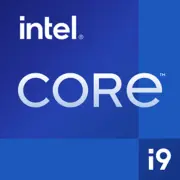Intel Core i9-13900T

Intel Core i9-13900T: Power in an Energy-Efficient Format
An overview of the processor for those who value the balance between performance and energy savings
Key Specifications: Raptor Lake in a Compact Package
Architecture and Manufacturing Process
The Intel Core i9-13900T processor, built on the Raptor Lake architecture, continues the tradition of a hybrid approach with a combination of Performance-cores (P-cores) and Efficient-cores (E-cores). It features 24 cores (8 P-cores + 16 E-cores) and 32 threads, providing multitasking capabilities on par with top models. The Intel 7 process (10 nm Enhanced SuperFin) is optimized for reducing power consumption without sacrificing speed.
Performance and Key Features
- Hybrid Architecture: P-cores operate at frequencies up to 5.3 GHz (Turbo Boost Max 3.0) for "heavy" tasks, while E-cores (up to 3.9 GHz) handle background processes.
- 36 MB L3 Cache: Reduces latency when processing data.
- Intel® UHD Graphics 770: Integrated graphics support 4K/60 Hz and AV1 hardware decoding.
- Geekbench 6: 2812 (Single-Core), 15784 (Multi-Core) — results are close to desktop monsters like the i9-13900K, but with a TDP of only 35 W.
Features:
- Supports PCIe 5.0 (up to 16 lanes) and Thunderbolt 4;
- Intel Thread Director technology for optimizing task allocation among cores;
- DLVR (Digital Linear Voltage Regulator) — reduces power consumption by 20-25% in idle mode.
Compatible Motherboards: Choosing a Platform
Sockets and Chipsets
The processor uses the LGA 1700 socket, compatible with Z790, B760, H770 chipsets.
- Z790: For enthusiasts — unlocked multiplier, RAM overclocking support (up to DDR5-7200), and 8-layer PCB for stability. Example: ASUS ROG Strix Z790-E Gaming ($350–400).
- B760: Budget option with support for DDR5 and PCIe 5.0. Example: MSI B760 Tomahawk WiFi ($180–220).
- H770: Basic features, no overclocking. Suitable for office builds.
Tip: If you plan to use DDR4, choose boards that support both standards (e.g., Gigabyte Z790 AORUS Elite AX DDR4).
Supported Memory Types: DDR4 vs DDR5
The processor works with DDR5-5600 and DDR4-3200.
- DDR5: Higher bandwidth (up to 48 GB/s) but more expensive. For instance, a 32 GB (2x16) DDR5-5600 kit from Corsair costs $120–150.
- DDR4: Budget-friendly choice. 32 GB DDR4-3200 will cost $70–90.
Recommendation: For work tasks (rendering, encoding), DDR5 is preferable. For gaming and everyday use, DDR4 will suffice.
Power Supplies: Energy Efficiency First
With a nominal TDP of 35 W, the actual consumption under load reaches 100–120 W (PL2).
- Minimum: 500 W (considering a discrete graphics card). Example: Corsair CX550M ($70).
- Optimal: 650–750 W (headroom for upgrades). Example: Seasonic FOCUS GX-750 ($130).
- Certifications: 80 Plus Gold or higher for efficiency >90%.
Important: In compact PCs (Mini-ITX), choose power supplies with modular cables (e.g., Cooler Master V750 SFX Gold).
Pros and Cons of i9-13900T
Pros:
- 24-core power at laptop-level energy consumption;
- Integrated graphics for office tasks and media centers;
- Support for DDR4/DDR5 and PCIe 5.0.
Cons:
- High price ($450–500) compared to AMD Ryzen 9 7900 ($400);
- Limited overclocking on B760/H770 chipsets;
- Heating of P-cores up to 95°C under sustained load (requires good cooling).
Use Cases
Gaming
With a discrete graphics card (e.g., NVIDIA RTX 4070), the i9-13900T achieves over 120 FPS at 1440p (Cyberpunk 2077, Horizon Zero Dawn). Integrated graphics can handle CS2 or Dota 2 at medium settings (60 FPS at 1080p).
Work Tasks
- Rendering: In Blender (BMW scene), completes the test in 4.5 minutes (compared to 5.2 minutes for Ryzen 9 7900);
- Encoding: HandBrake (4K to H.265) — 15% faster than i7-13700T.
Multimedia
Ideal for home servers and media centers: AV1 support, HDMI 2.1, able to handle multiple 4K streams simultaneously.
Comparison with Competitors
- AMD Ryzen 9 7900 (12 cores, 24 threads, TDP 65 W): Cheaper ($400), but lags in multi-threaded tasks (Geekbench 6 Multi-Core: ~14500).
- Apple M3 Max (16 cores, 40 W): Better in energy efficiency but limited compatibility with Windows software.
Practical Assembly Tips
1. Cooling: Even at low TDP, opt for a tower cooler (e.g., Noctua NH-U12S) or a 240 mm AIO.
2. Case: For mini PCs — Fractal Design Ridge; for standard builds — Lian Li Lancool 216.
3. Storage: Use PCIe 5.0 SSDs (e.g., Samsung 990 Pro) for maximum speed.
Final Conclusion: Who is the i9-13900T For?
This processor is ideal for:
- Compact PC enthusiasts wanting to build a powerful system in a Mini-ITX case;
- Professionals needing multi-threaded performance without skyrocketing electric bills;
- Media centers where silence and support for modern codecs are crucial.
The price of $450–500 is justified if you value the balance between power and energy efficiency. For purely gaming PCs, it's better to opt for the i5-14600K + discrete GPU, but for versatile tasks, the i9-13900T is one of the best options on the market for 2025.
Basic
CPU Specifications
Memory Specifications
GPU Specifications
Miscellaneous
Benchmarks
Compared to Other CPU
Share in social media
Or Link To Us
<a href="https://cputronic.com/cpu/intel-core-i9-13900t" target="_blank">Intel Core i9-13900T</a>